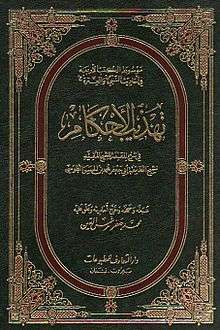Tahdhib al-Ahkam
 Front cover of Tahdhib al-Ahkam | |
| Author | Abu Jafar Muhammad Ibn Hassan Tusi |
|---|---|
| Language | Arabic |
| Media type | Book |


Tahdhib al-Ahkam (Persian: تهذیب الاحکام فی الشرح المقنعه) (Tahdhib al-Ahkam fi Sharh al-Muqni'a) is a Hadith collection, by Twelver Shia Hadith scholar Abu Jafar Muhammad Ibn Hassan Tusi, commonly known as Shaykh Tusi. This work is included among the four books of Shia Islam. It is a commentary on the Al-Muqni'yah by Al-Shaykh Al-Mufid, was a Twelver Shia theologian.[1][2]
Title
Tahdhib al-Ahkam is translated by Ludwig W. Adamec as confirmation of decision[3] and by I.K.A Howard as The Refinement of the Laws (as Discussed).[4]
Author
Abu Jafar Muhammad Ibn Hassan Tusi (Persian: ابوجعفر محمد بن حسن توسی) known as Shaykh al-Ta'ifah (Arabic: شيخ الطائفة) or Shaykh al-Tusi. Shaykh Tusi was born in 996 AD in Tus, Iran. He was a Persian Shia Twelver scholar and authored two references of Shia collections of tradition, Tahdhib al-Ahkam and Al-Istibsar. Al-Shaikh al-Tusi died in Najaf on the 22nd of Muharram on 2 December 1067.[5]
Background
Al-Istibsar is one of the four major Shia collections of Hadith (Persian: الكتب الاربعة) authored by Shaykh Tusi.[6] According to Ali Nasiri, when Shaykh Tusi transferred to Baghdad and participated in the class session of Shaykh al-Mufid, he found conflicting Hadith (traditions) in Shia sources. Due to his nomination at introduction of Tahdhib al-Ahkam,[4] he wrote the book as commentary on the Al-Muqni'yah for solving the crisis of contradiction in the Islamic seminary in response to his friend request. Ali Nasiri give three reason for selection Al-Muqni'yah by Shaykh Tusi: dignity of Al-Shaykh Al-Mufid, Al-Muqni'yah was based on Shia view and last reason is fruition of Al-Shaykh Al-Mufid’s intellectual and mental protection.[7]
Content
Shaykh Tusi explained his style in authoring the Tahdhib al-Ahkam in the introduction of it. According to view point of Ali Nasiri, Shaykh Tusi authored this book basis on the six phases:[7]
- Mention the jurisprudential issues by keeping the structure of the book al-Muqni by Shaykh al-Mufid
- Recounting their proof except tradition (Hadith): Shaykh Tusi nominated to three type of proof, the Quran, Sunnah and consensus (agreement of the Muslim scholars basically on religious issues). The types of Quranic evidence was described by him. Also, according to his belief, Sunnah may contain Mutawatir tradition or Ahaad. In view of Shaykh Tusi, consensus referred to agreement of Shia Muslim scholars.
- Recounting the Hadith proof: one of the fundamental part at Tahdhib al-Ahkam is to rely on the tradition that protect every issues.
- Recounting the conflicting proof: rectifying the conflicting tradition was a main purpose of Shaykh Tusi for authoring this book. So he devoted the main part of his work to examine such this tradition with tradition that verify every issues.
- Describing the way of rectifying concordant and conflicting traditions: after determining this type of tradition, Shaykh Tusi inspect the way of rectifying.
- Citing tradition in a bid to declare the interpretation: Shakh Tusi used interpretation and rationalization to rectifying concordant and conflicting traditions.
Therefore, Shaykh Tusi proceeded to his work in three step:[7]
- Transmitting tradition that verify every issue
- Transmitting tradition that contrast the first set of tradition
- Transmitting tradition that affirm the interpretation
Tahdhib al-Ahkam contains the following:[4]
- I: Ritual purity in Islam (Arabic: طهارة (Taharah))
- II: Prayer
- III: religious tax
- IV: fasting regulated by Islamic jurisprudence
- V: Pilgrimage
- VI: Sacred War
- VII: Judgements and Legal Requirements (Arabic: قضا و الاحکام)
- VIII: Acquisitions (Arabic: المکاسب)
- IX: Trade (Arabic: التجارت)
- X: Marriage in Islam
- XI: Divorce
- XII: Manumission of Slaves
- XIII: Oaths, Vows and Atonements
- XIV: Hunting and Ritual Slaughter
- XV: Endowments and Alms
- XVI: Bequests
- XVII: Formal Rules of Inheritance
- XVIII: Punishment prescribed by Revelation
- XIX: Indemnities for Bodily Injury
According to Najaf publication, Tahdhib al-Ahkam included 409 chapters, 13988 traditions and according to counting of Muhaddis Noori it included 393 chapters, 13590 traditions. This variance between reports had led by mistake in counting.[8]
See also
References
- ↑ Abd al-Hadi al-Fadli (1 September 2011). Introduction to Hadith 2nd. ICAS Press. pp. 106–7. ISBN 978-1-904063-47-6.
- ↑ Shaykh al-Mufid (15 September 2014). Al-Amali, The Dictations of Shaykh al-Mufid. Lulu.com. ISBN 978-1-312-52224-4.
- ↑ Ludwig W. Adamec (2 September 2009). The A to Z of Islam. Scarecrow Press. p. 104. ISBN 978-1-4616-7193-0.
- 1 2 3 Howard, I. K. A. Great Shi'i Works: 'Tahdhib al-Ahkam' and 'Al-Istibsar' by Al-Tusi.
- ↑ Josef W. Meri; Jere L. Bacharach (2006). Medieval Islamic Civilization: L-Z, index. Taylor & Francis. p. 839. ISBN 978-0-415-96692-4.
- ↑ Cyril, Huston; Glasse, Smith (2001). New Encyclopedia of Islam: A Revised Edition of the Concise Encyclopedia of Islam. AltaMira Press; Revised edition. pp. 148, 582. ISBN 978-0759101890.
- 1 2 3 ʻAlī Nāṣirī (28 February 2013). An Introduction to Hadith: History and Sources. MIU Press. p. 261. ISBN 978-1-907905-08-7.
- ↑ Encyclopaedia Institute of Islamic Fiqh. Enclopediya of Islamic world.
